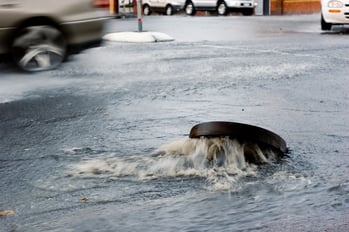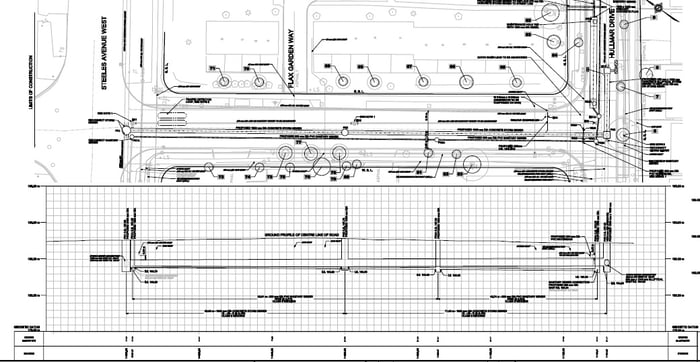The design and planning of a sewer system plays a key role in protecting our lakes, rivers and oceans—and the people and wildlife who swim in and drink from them. Treatment plants reduce pollutants, including the human waste, food scraps, chemicals and oils that accumulate in wastewater, so that it can be safely released into the environment.

Sewer systems are often laid out in a tree-like pattern. Branching pipes extend from the main line, with smaller sewers flowing into larger ones, which means that there is generally a single path of flow from the entry point to the sewer system terminus—the roots of the tree.
Designing a sewer system requires precise field measurements of elevation and distance as well as an understanding of the position, grade, and lengths of pipes and the labor and materials needed to get the job done. Because most sewer systems rely on gravity, sewer lines slope downward toward a wastewater treatment plant located at a lower elevation. In flat areas, pipes are buried on a gradient, starting shallow and going deeper until it’s no longer economical. When it isn’t feasible to bury pipes at a slope, wastewater is conveyed by pump and pressure, rather than gravity.
How Modern Sewer Systems Are Constructed
Most sewer systems in the early 20th century were built as combined sewer systems, meaning they had one pipe that conveyed a mix of sanitary sewer (household and industrial) water and stormwater. The volume of water they handle can increase dramatically during a heavy rainfall, causing the systems to discharge untreated water. Combined sewer overflow (CSO) can have a significant harmful impact on the environment.

Combined systems remain in use in many older communities in the U.S., but operators build separate ones when constructing new sewer systems. Separate systems have two pipes—one that carries household and industrial wastewater to a treatment plant, and another that directs runoff from street storm drains and roof drains to a nearby lake, river or ocean. They’re more efficient during wet weather, because stormwater is deposited directly in a nearby body of water rather than transferred to a treatment plant. They also help protect the environment by preventing sewage from overflowing onto roads and other sensitive areas.
What to Consider When Designing and Planning a Sewer System
Proper design and planning can help secure public support for a sewer system construction project and ensure that your community is getting the most out of its investment. Critical considerations for wastewater system planning include
- Topography: The natural and man-made physical features of an area, such as hills, valleys and rivers.
- Existing infrastructure: Structures and facilities, such as culverts, right-of-way ditches, and outfalls, as well as buried power and communication lines, gas facilities, and roadways.
- Budget: Resources available to keep the system functioning now and in the future.
- Capacity requirements: Future and existing needs based on flow.
- Population change: Planning for projected increases or decreases in regional population; larger and denser populations place a larger demand on the system.
- Urbanization: Shift of populations from rural to urban areas and the resulting change in stress on the sewer system.
- Environmental impact: The effect that installation, design choices, construction and water release will have on the natural surroundings.
- Regulations: Local, state and national requirements for wastewater management.
- Soil hydrology: The components related to irrigation, drainage, evaporation and transpiration that determine the flow of water.
- Surface loading: The weight supported per square unit of surface, as it impacts pipe strength and pressure.
- Provisions for infiltration: Steps taken to preserve functional performance even as pipes gradually corrode, rust and decay.

Photo Credit: By Silenzio76 - Own work, CC BY-SA 4.0, https://commons.wikimedia.org/w/index.php?curid=46457751
How Modeling Helps Engineers Anticipate Sewer System Performance
Modeling is the process of creating (and using) a wastewater collection system simulation for a specific system. The model itself is a tool used to plan infrastructure improvements, including evaluating configurations and alternatives to determine pipe sizes, elevations and alignments; develop operational maintenance strategies; and manage a sewer system proactively. It helps engineers understand how a system is likely to perform under different conditions.
The first modelings of collection systems were entirely manual, using tabular forms to calculate flows, water levels and hydraulic grade lines. Then, as computer processing became available, the calculations were performed digitally.
Several types of models are currently used to design and plan sewer systems, including
- Mathematical models, which use a set of equations to describe the physical process. The Manning equation, for example, is used to calculate the average flow velocity in a pipe or channel, while the hydraulic model is used to analyze a system’s hydraulic behavior and simulate the performance of the individual components and the collection system as a whole.
- Computer models, which reuse a numerical representation for computational analysis. For example, flow estimation modeling of expected peak wastewater flow.
- System models, which consist of a computer model in addition to all of the data necessary for a particular collection system.
How to Keep Sewer Systems Running Smoothly
The importance of regular inspection and maintenance cannot be overstated. Collecting and analyzing data at three main points—main lines, lateral lines and manholes—allows communities to prioritize repairs and prevent inflow and infiltration. Proactive inspections play a key role in ensuring that you are able to maximize ROI and the longevity of your system.
Ready to get your wastewater project started? Envirosight’s guide to grants for water and wastewater systems can help your community access the funding it needs to build sustainable and efficient infrastructure.

